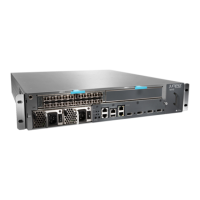slot-number can be 0 or 1. To configure the Routing Engine to be the master, specify the
master option. To configure it to be the backup, specify the backup option. To switch
between the master and the backup Routing Engines, you must modify the configuration
and then activate it by issuing the commit command.
The running state of a Routing Engine (master, backup, or disabled) is determined by
mastership election upon system boot.
•
Master—If a Routing Engine is configured as master, it has full functionality. It receives
and transmits routing information, builds and maintains routing tables, communicates
with interfaces and Packet Forwarding Engine components, and has full control over
the chassis. Once a Routing Engine becomes master, it resets the switch plane (SSB,
SCB, and SFM) and downloads its current version of the microkernel to the Packet
Forwarding Engine components, guaranteeing software compatibility.
•
Backup—If a Routing Engine is configured to be the backup, it does not maintain routing
tables or communicate with Packet Forwarding Engine or chassis components. However,
it runs through its memory check and boot sequence to the point of displaying a login
prompt. A backup Routing Engine supports full management access through the
Ethernet, console, and auxiliary ports, and can communicate with the master Routing
Engine. Additionally, a backup Routing Engine responds to the Routing Engine request
chassis routing-engine master switch command. The backup Routing Engine maintains
a connection with the master Routing Engine and monitors the master Routing Engine.
If the connection is broken, you can switch mastership by entering the switchover
command. If the master Routing Engine is hot-swapped out of the system, the backup
takes over control of the system as the new master Routing Engine. Once a Routing
Engine becomes master, it resets the switch plane and downloads its own version of
the microkernel to the Packet Forwarding Engine components.
•
Disabled—A disabled Routing Engine has progressed through its memory check and
boot sequence to the point of displaying a login prompt (similar to backup state) but
does not respond to a request chassis routing-engine master switch command. A Routing
Engine in disabled state supports full management access through the Ethernet,
console, and auxiliary ports, and can communicate with the master Routing Engine. A
disabled Routing Engine does not participate in a mastership election. To move from
disabled state to backup state, the Routing Engine must be reconfigured to be the
backup Routing Engine.
To configure RE1 to be the default master, issue the following command in configuration
mode at the [edit] hierarchy level:
For slot 0:
[edit]
user@host# set chassis redundancy routing-engine 1 master
[edit]
user@host# commit
For slot 1:
[edit]
user@host# set chassis redundancy routing-engine 0 backup
[edit]
579Copyright © 2012, Juniper Networks, Inc.
Chapter 28: Host Redundancy Overview

